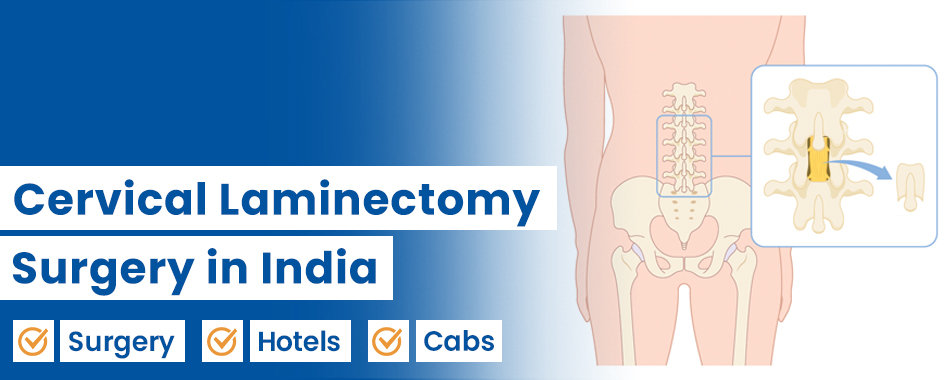

Within the last few years, Africa has experienced a significant rise in medical tourism, and thousands of patients have been opting to travel for health care services overseas. The most popular destination among African patients is India, where they come for relatively low-cost but advanced medical services and highly qualified medical specialists. Yearly, hundreds of patients from Kenya, Congo, Ethiopia and Nigeria are going to India for their surgical procedure, including cervical laminectomy.
India's healthcare sector has been transformed into a world leader. People come from all over the globe to receive treatment in our country with excellent medical personnel and advanced technology. The nation's high-quality hospitals and medical centres can perform different surgical procedures, such as a cervical laminectomy in India, cheaply compared to developed countries like the US and other European countries. In addition, India hosts highly educated and experienced surgeons and well-equipped medical facilities to ensure patients have a life-changing surgery experience.
A Cervical Laminectomy is a method doctors use to solve the issues of the neck’s back area of the collarbone. It mainly consists of re-sectioning or extracting the spinal vertebra bone called lamina, which is the covering or bony roof of the spinal canal. With this procedure, the doctors reduce the pressure on the spinal cord or nerve roots as they go through the cervical spine.
There are two types of cervical laminectomy: posterior cervical laminectomy and anterior cervical laminectomy. The posterior approach will require removing the lamina in the back of the spine. In contrast, the anterior approach may necessitate the portion of the vertebral body for the front of the spine to go through the removal.
Cervical spine laminectomy in India is performed in different ways. A surgeon can make an opening at the front or the back of the neck based on the type of approach. Through this operation, one can reach the spinal canal and remove a narrow lamina or bone with great care. These procedures aim to enlarge the space between the spinal cord and nerve roots, which will relieve pressure and ease symptoms.
Cervical laminectomy operation may be prescribed for different diseases, for example, cervical spinal stenosis (decreased canal), herniated or bulging discs, osteophytes, and compressed or irritated roots of the cervical nerves or spinal cord.
Other advantages of the cervical laminectomy procedure are essential to this surgery. The specific method is usually recommended for patients who have shown symptomatic improvement or physiological remedy after being treated with non-surgical procedures such as cervical cord dislocation or vertebral root compression in the upper section.
In the long run, there may be many potential ailments that a cervical laminectomy surgery should surgically treat, but cervical spinal stenosis happens to be one of them only. On the other hand, in the cervical vertebrae, the stenosis is referred to as the reduction of the foramen or spinal canal, which is pressure on the spinal cord and the nerve roots. The main circumstances that can provoke a cervical laminectomy, e.g. are herniated discs, bulging or extruded discs, bone spurs or other concomitant injuries or diseases of the cervical spine.
In some instances, a posterior cervical laminectomy to enhance the removal of some parts of the lamina at the rear of the cervical spine may be required. It will be this type of therapy most frequently the choice for the treatment of cervical spondylotic myelopathy or cervical radiculopathy when compression of the spinal canal or nerve roots is present.
As for this, on the contrary, an anterior cervical laminectomy with the removal of a minor part of the vertebral body from the head of the cervical spine may also take place. The most frequent neurosurgical treatment for a herniated disc or cervical spinal stenosis caused by degenerative bone spurs and other front-based spinal anomalies is a decompression surgery where the source of the compression, which is customarily the medial disc, is removed.
Cervical laminectomy provides an effective way to deal with pain and thereby boosts the overall life quality. The primary benefit of a cervical laminectomy surgery is the release of the pressure on the spinal cord or nerve roots. Removing a part of the lamina or spinal bone can make more space in the canal, leading to reduced compression and the nerves to work correctly.
Another advantage of a successful cervical laminectomy procedure is that it can alleviate intolerable or permanent neck pain, which interferes significantly with an individual’s daily routine. The origin of the pain is dealt with either by the herniated disc or the bone spur, and patients benefit from the reduction of the pain and improved mobility.
For patients who feel numb or weak in the upper or lower limb caused by compression of nerves, cervical laminectomy surgery in India can be performed to restore normal nerve functioning and allow muscle strength and coordination recovery. Thus, go for fine motor skills, balance, and general mobility.
One more advantage of posterior cervical laminectomy or anterior cervical laminectomy is the possibility of preventing further neurologic damage. The surgery tries to solve the issue when it is still immature or limited to mild compression or irritation. This will prevent permanent nerve damage or other complications resulting from prolonged compression.
It should be added that the laminectomy for the cervical spine may lead to beneficiary results as this question is dependent on the personal condition, severity of compression and other factors. Nevertheless, some patients may view this surgical procedure as the end of their sufferings and a way to recover the highest degree of life quality.
Cervical laminectomy in India is a very complex medical procedure that includes multiple steps. The most important thing to consider when choosing an experienced and skilled surgical team is to have a positive outcome.
Before cervical laminectomy, the patient undergoes a complete evaluation of the patient's history and the results of the diagnostic examination, which can be done via X-ray, CT scan, or MRI. It makes the surgeon pay a lot of attention to the patient's case and enables them to perform the operation step by step.
The patient undergoes general anaesthesia in the course of the surgery, which ensures they remain sleeping and pleased all the time. This is done by an anesthesiologist who has experience. They monitor the patient's vital signs, making the process safe and effective.
The location or the degree of compression will contribute to the choice of posterior cervical laminectomy or anterior cervical laminectomy by the surgeon. In the posterior approach, the spinal canal is accessed via the back of the neck through partial removal of the lamina, a protective bony layer surrounding the entire vertebra, and inserts where the muscle and nerve tissue run through the spine. A surgeon is going to conduct the anterior approach in front of the neck and is going to remove a cervical vertebra.
Once the surgeon gets into the spinal canal, they carefully remove the bone or disc that lies inside and press the spinal cord or the nerve roots. This could be accomplished by re-sectioning a small portion of the lamina, vertebral body, or herniated disc material.
The surgeon may even go ahead and perform additional procedures aimed at ensuring the stability of the cervical spine. This might encompass putting in those plates, screws, and bone grafts, among other things, to maintain the spinal alignment properly and to prevent future compression.
Then, after the decompression and all stabilisation procedures are taken care of, the wound is closed as carefully as possible using either sutures or surgical staples. Spots of drainage are made where no fluids are collected.
The patient is then taken to the recovery room, where he will be carefully watched and his vital signs tracked. Analgesics and other medications, in this case, can be used to maintain the patient's comfort and ensure that no potential problems would lead to complications.
Subsequently, an orderly rehabilitation phase will allow the patient to implement their rehabilitation program. Usually, physiotherapeutic exercises strengthen the neck muscles, improve the range of motion, and improve the condition overall. The rehab process is essential for the recovery period to have a smooth outcome and to return the use of body parts.
Note that these steps may change in the implementation of Cervical Laminectomy in India according to the patient's specifics, the surgeon's method choice, and local medical facility administrative authorities. However, the overall goal remains to precisely eliminate spinal cord or nerve root compression and improve the patient's condition.

CureIndia helps you connect with the top cervical laminectomy surgeons in India. CureIndia's trained neurosurgeons and orthopaedic surgeons specialise in performing cervical laminectomy, which uses modern procedures to reduce pressure on the spinal cord and nerves. Let us hear from the top cervical laminectomy specialists in India.




The patient might have some pain and grief in the neck cache zone, which will be relieved with the given pain medications. The water accumulation and swelling around the surgery site, along with bruising, are also quite every day.
The X-rays taken as a follow-up would confirm the recovery or the need for further treatment. Patients may need to wear a cervical collar or brace during the initial recovery period to support the neck and limit movement. This approach aids recovery and can prevent worsening of the inflammation.
The most prescribed therapy is physical therapy so that the incoordination of the neck and shoulder's work can be recovered after the cervical laminectomy procedure. The counsellor will indicate the correct type of exercises and activities and adjust the program per the client's necessity.
With the healing process turning the corner, patients should anticipate decreased aches and pains. Nevertheless, it is possible to note that cervical laminectomy surgery in India is an effective procedure. Still, one may experience the full benefits after a few weeks or months, including improved mobility, reduced numbness or weakness, and an overall enhanced quality of life.
An appointment with the surgeon now and then is needed to ensure proper healing, which will also help answer the questions that may arise or deal with any unforeseeable complications. By following the treatment procedure and the prescribed recovery plan, patients can expect a successful outcome and revamp from their symptoms consequential to the cervical spine.
Cervical laminectomy in India is affordably priced when compared with other countries. Still, the quality of their care and the experience of the specialists are well-kept.
The cost of cervical laminectomy in India is around $5,500 to $6,500, but the exact cost depends on several factors, including the hospital, the list of surgeons, and the case's complexity. This is just a fraction of the total cost of the procedure in the US, where the identical operation is priced between $30,000 and $100,000 and can sometimes be higher.
| Treatment Name | Cost in India | Stay in India |
|---|---|---|
| Cervical Laminectomy in India | $5,500 - $6,500 | 7 Days |
Besides the cost of exercise, other expenses include accommodation, travel, and post-operative care. Despite that, empirical verification is needed, even if those additional costs are included too, to establish unambiguously that the overall price of cervical laminectomy in India is still significantly less than in many other countries.
The point is that hospital or surgeon selections have to be based on more cost factors other than cervical laminectomy surgery in India. Alongside this, patients should have accreditations from the hospital, the surgeon's experience level, and their success rate in improving the care provided.
Patients opting for a cervical laminectomy procedure in India will experience excellent medical facilities, experienced surgeons, advanced technology, and vastly economical amounts due to the surgery prices of other healthcare destinations.
A cervical laminectomy is a method of surgery that is used to operate on individuals experiencing neck pain and numbness caused by pressure or bothering of the spinal cord or nerve roots. By deciding to undergo a cervical laminectomy in India, patients can profit from the elite clinical facilities, exceptionally gifted specialists, and cutting-edge innovation, all while getting a charge out of significant expenses.
The cervical laminectomy cost in India is meagre compared to what it would be in numerous nations, making it an attractive choice for those looking for reasonable yet excellent medical services.


Spinal Fusions, Decompressions and Deformity Corrections
Share Your Reports
Internationally Trained Spine Surgeons
Get an opinion
OAM Navigation, Microscopic and Neuro Monitoring Techniques
Plan Your Surgery